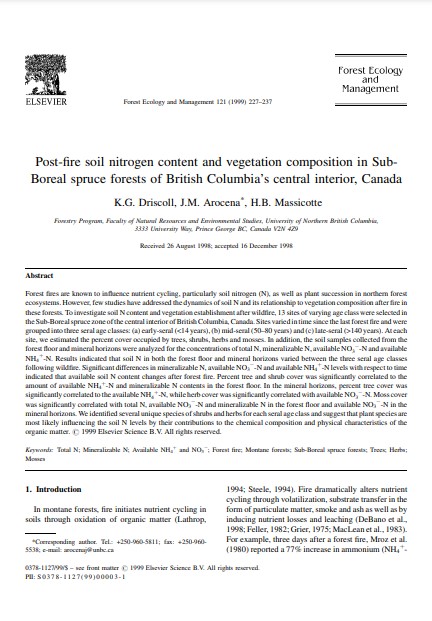Post-fire soil nitrogen content and vegetation composition in subboreal spruce forests of British Columbia's central interior, Canada
Bosque Modelo:
McGregor
Temática:
Gestión forestal
Tipo de documento:
Artículo científico
Resumen
Forest fires are known to influence nutrient cycling, particularly soil nitrogen (N), as well as plant succession in northern forest ecosystems. However, few studies have addressed the dynamics of soil N and its relationship to vegetation composition after fire in these forests. To investigate soil N content and vegetation establishment after wildfire, 13 sites of varying age class were selected in the Sub-Boreal spruce zone of the central interior of British Columbia, Canada. Sites varied in time since the last forest fire and were grouped into three seral age classes: (a) early-seral (<14 years), (b) mid-seral (50–80 years) and (c) late-seral (>140 years). At each site, we estimated the percent cover occupied by trees, shrubs, herbs and mosses. In addition, the soil samples collected from the forest floor and mineral horizons were analyzed for the concentrations of total N, mineralizable N, available NO3−-N and available NH4+-N. Results indicated that soil N in both the forest floor and mineral horizons varied between the three seral age classes following wildfire. Significant differences in mineralizable N, available NO3−-N and available NH4+-N levels with respect to time indicated that available soil N content changes after forest fire. Percent tree and shrub cover was significantly correlated to the amount of available NH4+-N and mineralizable N contents in the forest floor. In the mineral horizons, percent tree cover was significantly correlated to the available NH4+-N, while herb cover was significantly correlated with available NO3−-N. Moss cover was significantly correlated with total N, available NO3−-N and mineralizable N in the forest floor and available NO3−-N in the mineral horizons. We identified several unique species of shrubs and herbs for each seral age class and suggest that plant species are most likely influencing the soil N levels by their contributions to the chemical composition and physical characteristics of the organic matter.
Información Bibliográfica
Autor:
Driscoll, KG, JM Arocena and HB Massicotte.
Revista:
Forest Ecology and Management
Año:
1999
N°:
3
País :
Canadá
Páginas:
227 - 237
Volumen:
121
Idioma:
Ingles
Palabras claves
Total N; Mineralizable N; Available NH4 and NO3 ÿ; Forest ®re; Montane forests; Sub-Boreal spruce forests; Trees; Herbs; Mosses





